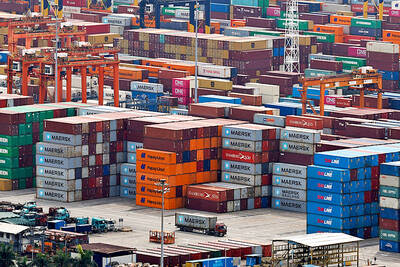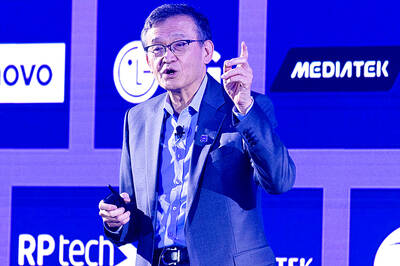The central bank yesterday said the New Taiwan dollar has been more stable than the South Korean won over the past three-and-a-half years, which has helped local exporters to reduce foreign exchange risk.
The comments came after Taiwan Semiconductor Manufacturing Co (TSMC, 台積電) chairman Morris Chang (張忠謀) last Friday criticized government agencies, including the central bank, of not doing enough to protect local companies from the impact of strong NT dollar gains against the US dollar.
In response, the central bank said in an e-mailed statement that it was not allowed to control the foreign exchange rate and that the bank opted for the policy of keeping the local currency at a managed floating rate.
In the more than three years since Dec. 31, 2007, the NT dollar’s fluctuation rate against the greenback was 4.15 percent, much tamer than the won’s rate of 14.51 percent, the statement said.
As the won’s fluctuation rate was 3.5 times higher than that of the NT dollar, Taiwanese firms in fact enjoyed lower currency exchange risks and that boosted their export business, the central bank said.
Chang said the foreign -exchange rate could make or break a company.
He said the South Korean government had done a better job in capping the appreciation of the won against the US dollar to protect its companies over the past year.
“As Taiwanese exporters book costs in New Taiwan dollars, the foreign exchange rate can affect their competitiveness,” Chang said.
The Japanese government has also sought to ease the strains of a strong yen recently, not to mention Beijing’s tough stance on keeping the yuan steady even under massive pressure from the US, Chang said.
Taiwan and South Korea -are competitors in similar categories of export products, and the central bank said it understood the concerns of Taiwanese companies, but said it could not manipulate the NT dollar because it had adopted a “managed floating” mechanism.
Taiwan and South Korea are long-time rivals in the technology field.
South Korean bigwigs such as Samsung Electronics Co and LG Electronics Inc manufacture products from handsets and LCD panels to chips and computers, products that are also manufactured by Taiwanese firms, including TSMC, HTC Corp (宏達電) and Acer Inc (宏碁).
Although a stronger NT dollar can impact companies’ profitability, on the other hand, Taiwan enjoys imported goods at a cheaper rate and that helps stabilize prices of domestic consumables, the statement said.
Taiwan’s Consumer Price Index (CPI) expanded 1.43 percent during the January to July period, compared to South Korea’s 4.4 percent, according to central bank statistics.
Taiwan’s CPI climbed 0.96 percent last year, while South Korea’s advanced 2.93 percent. In 2009, Taiwan’s CPI contracted 0.87 percent, but South Korea’s rose 2.83 percent.
The central bank said it would closely monitor the currency fluctuation, but intervention would only come when there are abnormalities such as huge capital inflow or outflow in the market that sends the NT dollar soaring or dropping on a great level.

The Eurovision Song Contest has seen a surge in punter interest at the bookmakers, becoming a major betting event, experts said ahead of last night’s giant glamfest in Basel. “Eurovision has quietly become one of the biggest betting events of the year,” said Tomi Huttunen, senior manager of the Online Computer Finland (OCS) betting and casino platform. Betting sites have long been used to gauge which way voters might be leaning ahead of the world’s biggest televised live music event. However, bookmakers highlight a huge increase in engagement in recent years — and this year in particular. “We’ve already passed 2023’s total activity and

Nvidia Corp CEO Jensen Huang (黃仁勳) today announced that his company has selected "Beitou Shilin" in Taipei for its new Taiwan office, called Nvidia Constellation, putting an end to months of speculation. Industry sources have said that the tech giant has been eyeing the Beitou Shilin Science Park as the site of its new overseas headquarters, and speculated that the new headquarters would be built on two plots of land designated as "T17" and "T18," which span 3.89 hectares in the park. "I think it's time for us to reveal one of the largest products we've ever built," Huang said near the

China yesterday announced anti-dumping duties as high as 74.9 percent on imports of polyoxymethylene (POM) copolymers, a type of engineering plastic, from Taiwan, the US, the EU and Japan. The Chinese Ministry of Commerce’s findings conclude a probe launched in May last year, shortly after the US sharply increased tariffs on Chinese electric vehicles, computer chips and other imports. POM copolymers can partially replace metals such as copper and zinc, and have various applications, including in auto parts, electronics and medical equipment, the Chinese ministry has said. In January, it said initial investigations had determined that dumping was taking place, and implemented preliminary

Intel Corp yesterday reinforced its determination to strengthen its partnerships with Taiwan’s ecosystem partners including original-electronic-manufacturing (OEM) companies such as Hon Hai Precision Industry Co (鴻海精密) and chipmaker United Microelectronics Corp (UMC, 聯電). “Tonight marks a new beginning. We renew our new partnership with Taiwan ecosystem,” Intel new chief executive officer Tan Lip-bu (陳立武) said at a dinner with representatives from the company’s local partners, celebrating the 40th anniversary of the US chip giant’s presence in Taiwan. Tan took the reins at Intel six weeks ago aiming to reform the chipmaker and revive its past glory. This is the first time Tan